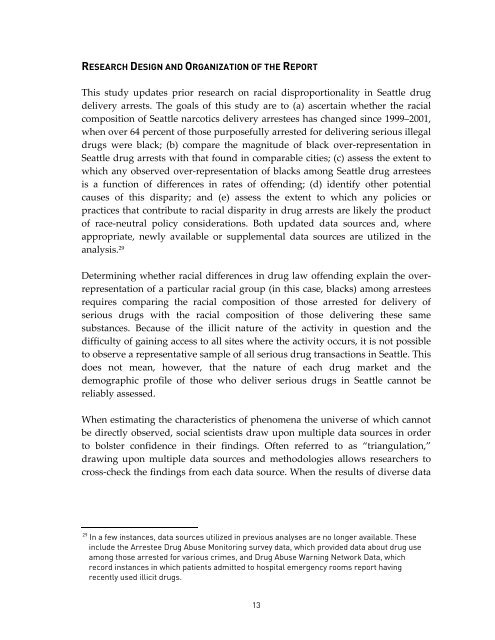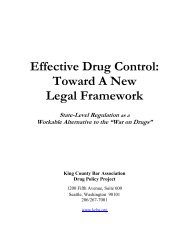RACE AND THE ENFORCEMENT OF DRUG DELIVERY LAWS IN ...
RACE AND THE ENFORCEMENT OF DRUG DELIVERY LAWS IN ...
RACE AND THE ENFORCEMENT OF DRUG DELIVERY LAWS IN ...
You also want an ePaper? Increase the reach of your titles
YUMPU automatically turns print PDFs into web optimized ePapers that Google loves.
RESEARCH DESIGN <strong>AND</strong> ORGANIZATION <strong>OF</strong> <strong>THE</strong> REPORT<br />
This study updates prior research on racial disproportionality in Seattle drug<br />
delivery arrests. The goals of this study are to (a) ascertain whether the racial<br />
composition of Seattle narcotics delivery arrestees has changed since 1999–2001,<br />
when over 64 percent of those purposefully arrested for delivering serious illegal<br />
drugs were black; (b) compare the magnitude of black over-representation in<br />
Seattle drug arrests with that found in comparable cities; (c) assess the extent to<br />
which any observed over-representation of blacks among Seattle drug arrestees<br />
is a function of differences in rates of offending; (d) identify other potential<br />
causes of this disparity; and (e) assess the extent to which any policies or<br />
practices that contribute to racial disparity in drug arrests are likely the product<br />
of race-neutral policy considerations. Both updated data sources and, where<br />
appropriate, newly available or supplemental data sources are utilized in the<br />
analysis. 29<br />
Determining whether racial differences in drug law offending explain the overrepresentation<br />
of a particular racial group (in this case, blacks) among arrestees<br />
requires comparing the racial composition of those arrested for delivery of<br />
serious drugs with the racial composition of those delivering these same<br />
substances. Because of the illicit nature of the activity in question and the<br />
difficulty of gaining access to all sites where the activity occurs, it is not possible<br />
to observe a representative sample of all serious drug transactions in Seattle. This<br />
does not mean, however, that the nature of each drug market and the<br />
demographic profile of those who deliver serious drugs in Seattle cannot be<br />
reliably assessed.<br />
When estimating the characteristics of phenomena the universe of which cannot<br />
be directly observed, social scientists draw upon multiple data sources in order<br />
to bolster confidence in their findings. Often referred to as “triangulation,”<br />
drawing upon multiple data sources and methodologies allows researchers to<br />
cross-check the findings from each data source. When the results of diverse data<br />
29<br />
In a few instances, data sources utilized in previous analyses are no longer available. These<br />
include the Arrestee Drug Abuse Monitoring survey data, which provided data about drug use<br />
among those arrested for various crimes, and Drug Abuse Warning Network Data, which<br />
record instances in which patients admitted to hospital emergency rooms report having<br />
recently used illicit drugs.<br />
13

















